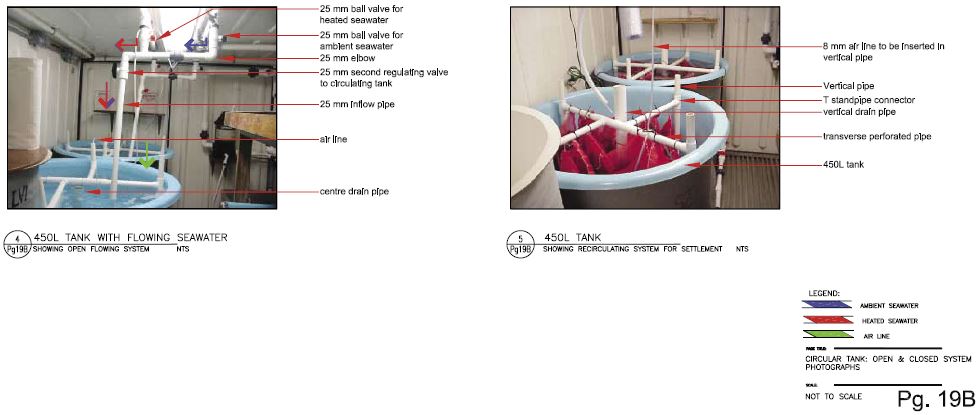4.2 SCIENTIFIC BACKGROUND – SETTLEMENT AND METAMORPHOSIS
The goal of the nursery is to grow large quantities of juvenile scallops quickly from setting size (200 µm) to approximately 5 mm shell height. At this time, they can be transferred to the natural environment for growth to market size (60 mm).
The nursery phase in Bermuda can be divided into two stages. The first stage, referred to here as the indoor nursery, involves settlement of mature larvae and post-larval growth of scallops to approximately 2 mm shell height. The second stage, the outdoor nursery, is optional and involves the further rearing of scallops from 2 mm to a minimum of 5 mm and up to 10 mm.
The first nursery stage allows for enhanced survival of juveniles when spat, rather than newly settled larvae are transferred to the field; as has been reported in the literature, survival rate of juveniles in the field is dependent on size at transfer.
For example, Bourne and Hodgson (1991) show that immediate transfer of mature larvae to the
Technical drawing, Pg. 19B
Circular tanks: Open and closed system photographs

field results in a 2.6 percent survival to 1.5-3.5 cm juveniles. This low survival implies costly hatchery operations and a minimal survival to 10 percent is recommended for economic viability by these authors. The second nursery stage where spat are reared for a longer time period, not only further enhances survival following transfer but also results in a reduction of labour and time required to reach adult/market size; this, therefore maximizes cost-efficiency of a growout operation. In this instance, however, costs in the nursery are increased to rear to a larger size.
4.2.1 Factors affecting settlement and metamorphosis
The process by which marine invertebrate planktonic larvae transform to become bottom dwelling juveniles can be divided into two stages; settlement, a repeatable behavioural stage, and metamorphosis, an irreversible physiological stage. Many mature invertebrate larvae have been induced to metamorphose in response to specific environmental cues – i.e. chemical, photic and tactile cues which may indicate the presence of a substratum or habitat suitable for juvenile life (Crisp, 1974; Hadfield, 1977; Burke, 1983).
In order to develop an efficient nursery system and obtain a reliable number of juveniles per larval batch, optimizing the number of larvae setting and metamorphosing into post-larvae is critical. This phase in the culture cycle is most probably the one where aquaculturists have the least control. It is a critical stage in the life of scallops and high mortalities can occur at this time, as early juveniles are extremely fragile. Bourne, Hodgson and Whyte (1989) report that for the Japanese scallop highest mortalities occur at 0.4–0.6 mm shell height, immediately following metamorphosis. The causes for mortalities seen in the nursery are unknown and are attributed to poor nutrition or improper handling. In an attempt to induce metamorphosis and enhance the number of mature larvae setting, several methods have been investigated for commercially important bivalves. Chemicals, such L-DOPA, norepinephrine and serotonin have been tested on Japanese scallop, P. yessoensis mature larvae (Bourne and Hodgson, 1991). Other cues such as cold temperature shock have also been tested on the same species (Kingzett, Bourne and Leask, 1990). Greatest increase in percent metamorphosis (17–19 percent over controls) was obtained with norepinephrine. The procedure is relatively simple and involves exposure of mature larvae to a diluted solution of the chemical (10-4M-10-6M) for a short time period (60 minutes) prior to settlement. Other authors have obtained complete metamorphosis within 12 h of exposure to glycine and theophylline (Naidenko, 1991 – on Swiftopecten swifti). Physical stimuli such as a sudden decrease in water temperature may also influence the onset of settlement, as demonstrated by Bourne and Hodgson (1991) for rock scallop, Crassadoma gigantea, larvae when chilled from 15 °C to 5 °C.
Generally, successful settlement and metamorphosis for bivalves only occur when larvae are “healthy”. One of the most critical factors is the accumulation of reserves throughout the larval life, related to food ration in both a qualitative and quantitative sense (Farias, Uriarte and Castilla, 1998). It has been shown that rearing conditions affect storage and utilization of biochemical components, and hence metamorphosis and settlement (Gallager and Mann, 1981). Rearing techniques described in Chapter 3 for sub-tropical pectinid species have proved adequate in yielding mature larvae with necessary biochemical reserves. This is certainly true for larvae reared in conventional static system, as well as in low-density experimental flow-through system, (Sarkis, Helm and Hohn, 2006). The effect of rearing techniques on post-larval settlement was seen in several instances, namely that of adequate food ration. The standard diet used at the BBSR hatchery has proved adequate over the years for ensuring good spat settlement and food ration is calculated on the basis of water volume within the tank. However, this approach was not found correct for a flow-through system supporting an increased density of larvae. Sarkis, Helm and Hohn (2006) demonstrated poor survival to post-larval stage for larvae reared in a high-density flow-through; this study has furthermore identified the need to base food ration on biomass rather than water volume for such a system.